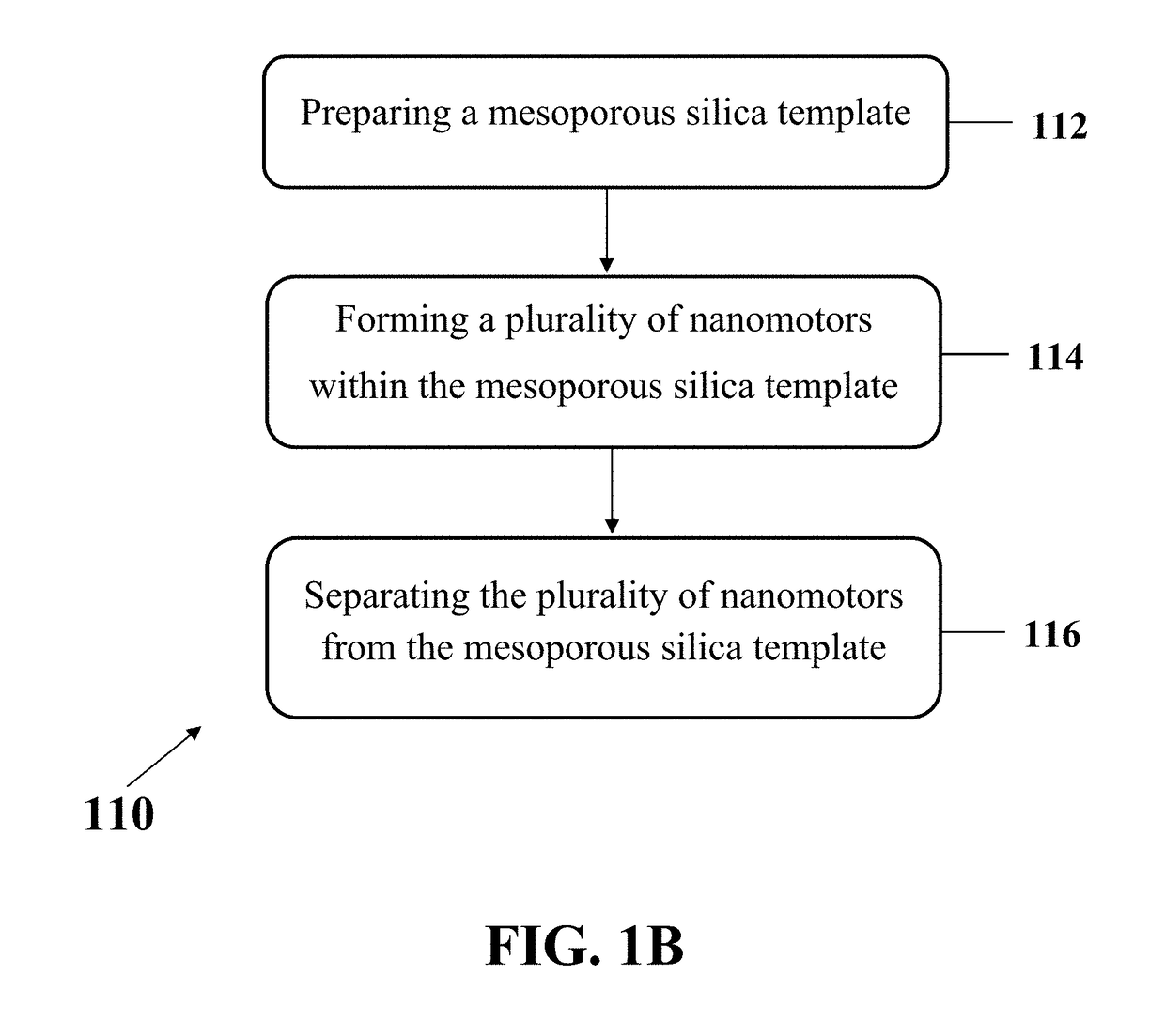Fabrication of nanomotors and applications thereof
a nano-motor and nano-rod technology, applied in the field of nano-motors, can solve the problems of large pollution of soils and waters, high cost of most of the used templates, and general micrometer scale of the nano-rod shape motor
- Summary
- Abstract
- Description
- Claims
- Application Information
AI Technical Summary
Benefits of technology
Problems solved by technology
Method used
Image
Examples
example 1
on of Oriented Mesoporous Silica Template
[0083]In this example, an exemplary plurality of nanomotors were fabricated using oriented mesoporous silica films obtained by electro-assisted self-assembly (EASA). An oriented mesoporous silica modified electrode was prepared according to the following procedure. Briefly, tetraethoxysilane (TEOS, 99%, 75 mM) and cetyltrimethylammonium bromide (CTAB, 99%, 24 mM) were added to a solution including about 20 mL of ethanol, and about 20 mL of an aqueous solution of NaNO3 (0.1 M) while stirring. HCl (36%) was added in order to reach a pH value of about 3. The solution was aged under stirring for about 2.5 hours at pH value of about 3 in order to produce hydrolyzed precursors before the electrosynthesis of mesoporous silica process. Then, a graphite rod electrode (0.5 cm diameter, and 2 cm length) was immersed in the obtained aged solution and a voltage of about −2.2 V versus Ag|AgCl|KClsat was applied for about 20 seconds in order to generate the...
example 2
on of Nanomotors
[0085]In this example, a plurality of exemplary nanomotors were fabricated within the channels of an exemplary mesoporous silica template fabricated in accordance with EXAMPLE 1 hereinabove. In the first step, a sacrificial layer of Prussian blue (PB) was deposited using chronoamperometry under the potential of about +0.3 V for about 5 minutes by immersing the oriented mesoporous silica modified electrode in a fresh solution containing FeCl3 (0.1 mM), potassium ferricyanide (K3[Fe(CN)6]) (0.1 mM) and KCl (0.1 M) to penetrate inside the mesoporous channels of silica. In the second step, the modified electrode was immersed in a NaNO3 (0.1 M) solution containing Na2PtCl6 (0.01 mM) and an electrical voltage of about −0.45 V was applied for about 10 minutes for electrochemical reduction of Na2PtCl6 inside the mesoporous channels of silica. In the third step, the obtained modified electrode was washed with water and immersed in NiCl2 (0.005 mM) solution containing H3BO3 (0...
example 3
e Control of Nanomotors
[0088]In this example, the fabricated nanomotors of EXAMPLE 2 were guided in a solution containing about 1% hydrogen peroxide (H2O2), as a fuel, by a magnetic force. A neodymium (NdFeB) magnet was used for magnetically controlled movement of the nanomotors.
[0089]FIGS. 6A-6D show a series of optical images demonstrating the route of the nanomotor with the elapse of time from FIG. 6A to FIG. 6D in a duration of about 1 second in the solution containing about 1% hydrogen peroxide (H2O2), as a fuel, via a magnetically guided movement, consistent with one or more exemplary embodiments of the present disclosure. As shown in FIGS. 6A-6D, in the presence of an external magnetic force, the catalytic nanomotors move towards the magnetic direction, wherein the arrows show the direction of the applied magnetic field.
PUM
| Property | Measurement | Unit |
|---|---|---|
| Diameter | aaaaa | aaaaa |
| Diameter | aaaaa | aaaaa |
| Electric potential / voltage | aaaaa | aaaaa |
Abstract
Description
Claims
Application Information
 Login to View More
Login to View More - R&D
- Intellectual Property
- Life Sciences
- Materials
- Tech Scout
- Unparalleled Data Quality
- Higher Quality Content
- 60% Fewer Hallucinations
Browse by: Latest US Patents, China's latest patents, Technical Efficacy Thesaurus, Application Domain, Technology Topic, Popular Technical Reports.
© 2025 PatSnap. All rights reserved.Legal|Privacy policy|Modern Slavery Act Transparency Statement|Sitemap|About US| Contact US: help@patsnap.com



